Project Business Case
Thorndon Connections Transitional Project
WCC Project ID
6,698
WCC Classification Tool
Moderate
Outcome
Senior Responsible
Vida Christeller
Business Owner
Brad Singh
Owner
Funding sought by
$3,163,609
Cost Code (CC)
2094
this Business Case
Funding Source
WCC with potential for
Recorded on Annual Plan Yes
funding assistance
from Transport
Choices (CERF) at up
t0 90% FAR
Trove Folder
WCC Project Business
Project Cost Code
CAP00097988
Location
Case MODERATE
Thorndon
Connections.docx

WCC Project Business Case MODERATE template.docx (Moderate) Thorndon Connections Transitional Project
Page 2 of 40
Template Properties
These are the details of the template used to create this document. This section cannot be edited.
Template Name
Project Business Case (Moderate)
Template Owner
Project Governance, Legal & Risk
Template Version
V1.1 2020
Document Properties
This table describes the properties of the document.
Author
Renee Corlett
Project Manager
Renee Corlett
Location
WCC Project Business Case MODERATE Thorndon Connections.docx
Document History
This table provides a history of changes made when completing this document.
Version No.
Date
Summary of Changes
1
27/09/22
Initial Draft
Related Documents
This table lists the documents that support the Business Case (delete/add as applicable)
Document
Name and Link
Council Paper(s)
Paneke Pōneke: Bike Network Plan
Project Brief
Project Brief- Thorndon Connections.docx
Statement of Work (if applicable)
Assurance Plan
Authority Signatures
The SRO approves this document as the baseline for the project and grants approval to move to the Plan stage of the IDF.
WCC Project Business Case MODERATE template.docx (Moderate) Thorndon Connections Transitional Project
Page 3 of 40
link to page 6 link to page 7 link to page 7 link to page 8 link to page 8 link to page 9 link to page 12 link to page 12 link to page 14 link to page 16 link to page 16 link to page 18
Prepared by; Renee Corlett
Signature
Please print; Renee Corlett
Project lead
Name
Title
Date
Approved by;
Signature
Please print;
Name
Title
Date
Table of Contents
1.
Purpose of this Document ........................................................................................................................... 6
2.
Executive Summary .................................................................................................................................... 7
2.1.
Recommendation ............................................................................................................................ 7
3.
Strategic Case/The Case for Change ......................................................................................................... 8
3.1.
Background/ context ....................................................................................................................... 8
3.2.
Strategic Context ............................................................................................................................ 9
3.3.
Problem statement ........................................................................................................................ 12
3.4.
Identified Benefits ......................................................................................................................... 12
3.5.
Measurable benefits from addressing specific problems on these routes: .................................. 14
4.
Options Analysis ....................................................................................................................................... 16
4.1.
Options Summary ......................................................................................................................... 16
4.2.
Options considered and preferred option ..................................................................................... 18
WCC Project Business Case MODERATE template.docx (Moderate) Thorndon Connections Transitional Project
Page 4 of 40
link to page 28 link to page 28 link to page 29 link to page 29 link to page 29 link to page 30 link to page 30 link to page 30 link to page 31 link to page 33 link to page 33 link to page 36 link to page 36 link to page 37 link to page 37 link to page 38 link to page 39 link to page 40 link to page 40 link to page 40 link to page 40 link to page 40
5.
Procurement Approach ............................................................................................................................. 28
5.1.
What is our procurement approach? ............................................................................................ 28
6.
Funding Approach ..................................................................................................................................... 29
6.1.
Funding Arrangement ................................................................................................................... 29
6.2.
Operational/Post Project Funding ................................................................................................. 29
6.3.
BCR .............................................................................................................................................. 30
7.
Project Management Approach ................................................................................................................ 30
7.1.
Project Approach .......................................................................................................................... 30
7.2.
Implementation Plan ..................................................................................................................... 31
7.3.
Transitional projects governance structure ................................................................................... 33
7.4.
Risk and Assurance Planning ....................................................................................................... 33
7.5.
Change Management Approach ................................................................................................... 36
7.6.
Benefits Management Approach .................................................................................................. 36
7.7.
Project Management Planning ...................................................................................................... 37
7.8.
Next Steps .................................................................................................................................... 37
8.
Recommendations .................................................................................................................................... 38
Appendix 1.
Investment Logic Map ............................................................................................................... 39
Appendix 2.
Multi Criteria Analysis Criteria and Scoring Scale .................................................................... 40
Appendix 3.
Concept Designs ...................................................................................................................... 40
Appendix 4.
BCR calculation ........................................................................................................................ 40
Appendix 5.
Monitoring and Evaluation Plan ................................................................................................ 40
Appendix 6.
Project Control Book ................................................................................................................. 40
WCC Project Business Case MODERATE template.docx (Moderate) Thorndon Connections Transitional Project
Page 5 of 40
1. Purpose of this Document
The purpose of the Business Case is to enable a robust process that captures what the project (business problem or business need) is, what investment is required,
what are the available options and associated costs to deliver the preferred solution.
The five sections used within this document are based on good practice in both central and local government and cover the following:
1. The Case for Change
Reason for the project– provides supporting information as to why the project is required
2. Options Analysis
Compare solutions – provides possible solution options and the preferred option
3. Procurement Approach
Procurement strategy – provides options on how the solution will be obtained and from where
4. Funding Approach
Funding arrangements – provides funding options, project/programme and ongoing costs
5. Project Management Approach
Delivery plan – provides high level information as to how the project/programme is going to be managed and delivered
WCC Project Business Case MODERATE template.docx (Moderate) Thorndon Connections Transitional Project
Page 6 of 40
2. Executive Summary
This business case seeks formal approval to proceed with the Thorndon Connections transitional project beyond concept designs and on to completion of design,
public consultation, and pending Council approval, installation evaluation and adaptation. .
The Thorndon Connections Transitional project is part of the transitional programme accelerating the installation of Paneke Pōneke – the Bike Network plan, ahead of
the more permanent projects. This project will accelerate the delivery of benefits by 3-4 years as the Transformational project is not due for physical works completion
until 2027.
The proposed cycle routes will connect into the Botanic Gardens to City transitional bike and bus improvements and Let’s Get Wellington Moving projects: the Golden
Mile, Thorndon Quay and Featherston Street upgrades.
The project seeks to address the following key problems:
-
Low cycling uptake due to lack of infrastructure and slow delivery
-
Low cycle mode share affecting carbon reduction and health
-
Poor infrastructure and road user behaviour contributing to higher-than-average rates of harm to cyclists
The project will deliver the following key benefits:
• Improved safety and perception of safety for people on bikes and walking
• Increased numbers of people cycling
• Increased mode shift away from single occupancy vehicles resulting in reduced emissions
A monitoring and evaluation plan is in place to measure baselines and ensure ongoing evaluation of benefits post installation.
The project has worked through the following concept design process with the Future Group Consortium:
• Longlisting of options
• Shortlisting of options
• Multicriteria analysis of shortlist (including 2 rounds of review by internal programme squad and external working group)
• Concept designs
The preferred concepts and rationale are outlined in this business case.
The total we seek approval for with this business case is the total cost for design construction and installation: $3,163,609
The project has a BCR of 1.08 with total benefits of $234,064 over a 5 year period.
2.1. Recommendation
We recommend that the SRO approves this business case so that the project may proceed to 90% design, public consultation 100% design and construction.
WCC Project Business Case MODERATE template.docx (Moderate) Thorndon Connections Transitional Project
Page 7 of 40
3. Strategic Case/The Case for Change
3.1. Background/ context
There has been strong commitment by the Council to develop a safe and connected bike network for the city.
Paneke Pōneke - Bike Network Plan was adopted on 10
March 2022. It sets the strategic direction for investment in a bike network, alongside multi-modal improvements. The objective is to improve safety and connectivity
for pedestrians, cyclists, and other active travellers of all ages and abilities to create a city where people can move easily and freely without relying on private vehicle
transport. This is vital to help reduce transport carbon emissions as part of
Te Atakura First to Zero, the city’s climate action plan.
The transitional programme uses interim installations to provide a ‘first cut’ of the whole route using adaptable materials. Following consultation with the community on
the designs, the Council will gather further feedback on the changes once they are installed and can make improvements to things such as signs, street markings,
parking and the position of dividers between the bike lanes and traffic. Using this process, we will develop and deliver key sections of the bike network in collaboration
with the community over the next few years.
The first two transitional projects (Newtown to the City and Botanic Garden ki Paekākā) will have construction underway in 2022, with the next tranche of project
design and development now underway for connections to Aro Valley, Ngaio, and Newtown to Island Bay.
This project is about linking together existing infrastructure investments in the Thorndon/ CBD area (blue in the picture below) including the Botanic Garden to city
cycleway, the Golden Mile and the Thorndon Quay/ Featherston Street cycleway. It includes the yellow routes below: Bowen Street west and Lambton Quay east ,
Hill Street and Tinakori Road and Molesworth, Mulgrave and Murphy Street, also Aitken Street and Pipitea Street.
Tinakori Road and Hill Street are classified as secondary routes while Molesworth, Mulgrave, Murphy and Lambton are primary connecting Wadestown to the city.
Aitken Street and Pipitea Street were not classified as part of the primary or secondary network in the Bike Network Plan but included within the scope of this project
based on feedback from the working party through concept design phase and to ensure better connectivity through the area. This includes better connection to
Wellington Girls College and a more direct route along Aitken Street to the bi-directional facility on Molesworth to the CBD along Lambton Quay. These streets will
only receive minor improvements such as traffic calming and cycle sharrows, with reallocation of angled parks on Aitken Street.
Bunny Street East was originally included in scope at the project brief stage but has subsequently been removed due to the overlap with LGWM. Bunny Street East
currently has some cycling provisions in place and transitional programme improvements were not deemed appropriate due to the large-scale pedestrian
improvements and larger network planning work needed to be undertaken in this area.
Stats 2018 census data indicates 4.4% of people travel from Wadestown to work on bike, with 20.3% walking or jogging which is higher than the average for
Wellington City and highlights the need for improvements to cycling and walking infrastructure within this area.
A
project brief was endorsed by the Portfolio Investment Review Committee (previously TPPP) in May and was retrospectively approved by the SRO on Tuesday 11th
October.
WCC Project Business Case MODERATE template.docx (Moderate) Thorndon Connections Transitional Project
Page 8 of 40
 3.2. Strategic Context
3.2. Strategic Context
The proposed investment in cycle routes in Thorndon aligns with national, regional, and local transport strategy and policy. Its core focus is on improved safety and
enabling more people to walk and cycle so we can reduce the city’s emissions and support healthy ways of getting around.
The project is part of the rapid roll-out of a bike network which is a Council priority in the Long Term Plan. It aligns with the following Wellington City Council (WCC)
policies and plans:
WCC Project Business Case MODERATE template.docx (Moderate) Thorndon Connections Transitional Project
Page 9 of 40
•
Paneke Pōneke / the Bike Network Plan was approved by Wellington City Councillors in March 2022. The objective of the plan is to improve safety and
connectivity for pedestrians, cyclists, and users of scooters of all ages and abilities, and to reduce transport carbon emissions as part of
Te Atakura, the city’s
climate action plan.
• The
Long-term Plan (LTP) has an accelerated delivery focus for cycleways.
o WCC has committed to investing $231 million to deliver the Cycling Master Plan over a 10-year period (assuming co-funding from Waka Kotahi of
approximately half this amount). This included pulling $52 million forward into Years 1-3 to accelerate delivery through transitional cycleways.
o Priority Objective 3 in the LTP is that the city’s core transport infrastructure is a safe, resilient, reliable network that supports active and public
transport choices, and an efficient, productive and an environmentally sustainable economy.
•
The Spatial plan for Wellington City has a strategic imperative of enabling low-carbon transport options, aiming to provide better accessibility, safer
environments for active modes of transport, and move more people around with fewer vehicles.
•
Climate Action Area, that of better ways to move around the city, include the bike network, pedestrian safety, public transport and considering the city's
growth.
•
District Plan Objective 4.2.12 – Access; aims to improve access for all people, particularly people travelling by cycle.
•
Wellington Towards 2040: Smart Capital (Strategic Plan) puts focus on having a connected and people-centred city.
•
The Parking Policy objectives include supporting a shift in mode of transport used and supporting safe movement.
•
As part of the Social Wellbeing Framework, Council recognizes its role in promoting cycling networks and active transport for personal safety and
resilience, allowing people to live better lives and better contribute to the city.
In addition, these objectives align with the wider regional and national policies below:
• The
Wellington Regional Land Transport Plan (RLTP) 2021-2031 has headline targets for carbon emissions, safety, and mode share.
•
Land Transport Management Act (2013): The relevance of considering legislation is that all transport proposals are required to be assessed against the
objectives and purpose of the LTMA (2003). The purpose of the LTMA is to “contribute to an effective, efficient, and safe land transport system in the public
interest”.
•
Government Policy Statement on Land Transport 2021 includes strategic priorities of improved access to a range of transport choices, promoting mode
shift, and safety.
•
Emissions Reduction Plan - Path towards meeting long-term climate targets, and a low emissions future. An action is the preparation of a National Cycling
Plan (see below),
•
Waka Kotahi National Cycling Plan – a plan to accelerate delivery of urban cycle networks to activate mode-shift and drive down carbon emissions.
•
Waka Kotahi Toitū Te Taiao – Our Sustainability Action Plan. A vision for a low carbon, safe and healthy land transport system.
• There is also consistency between the aim of the project and the target in the national
Climate Change Response Act 2002 of net zero greenhouse gas
emissions by 2050.
•
Waka Kotahi Road to Zero – NZ's road safety strategy, two of the main focus areas of which are infrastructure improvements and road user choices.
Let’s Get Wellington Moving (LGWM)
WCC Project Business Case MODERATE template.docx (Moderate) Thorndon Connections Transitional Project
Page 10 of 40
• The project is working closely with LGWM who are working on Golden Mile and Thorndon Quay cycleways providing useful connections into these proposed
solutions.
Wider Programme of work
Transitional projects such as the Thorndon Connections are part of a strategic programme of work to fast track the realisation of benefits identified in the Bike Network
Plan. The other projects are listed in the table below. The table lists the Transitional- and Transformational Projects indicating the timing for each project.
Transitional Timing –
Transformational (or
Project
Physical works completed
LGWM)
Botanic gardens – Waterfront (underway)
Feb 2023
Mar 2026 (LGWM)
Newtown - Waterfront (underway)
Feb 2023
2026 (LGWM)
Ngaio (underway)
Q1 23/24
Feb 2028
Aro Valley
(underway)
Q1 23/24
Mar 2027
Kilbirnie Connections
(underway)
Q2 23/24
May 2030
Thorndon Connections (underway)
Q4 23/24
Dec 2027
Newtown – Island Bay (underway)
Q2 23/24
Dec 2027 (LGWM)
Khandallah connection
Q4 23/24
Nov 2029
Ngaio – Johnsonville
Q1 24/25
Nov 2029
Salamanca Rd – Northland
Q1 24/25
Apr 2028
Eastern Package
Q1 24/25
Jan 2032
Newtown centre to zoo/SWIS
Q1 24/25
Mar 2029
Botanic – Karori
Q2 24/25
Jan 2031
Ngaio – Karori
Q2 24/25
Aug 2033
Thorndon – Wadestown
Q2 24/25
Aug 2033
Newlands connection
Q4 24/25
Jun 2034
WCC Project Business Case MODERATE template.docx (Moderate) Thorndon Connections Transitional Project
Page 11 of 40
3.3. Problem statement
The problems are aligned with the Investment Logic Mapping included in the Wellington Bike Network Plan (Paneke Pōneke) PBC (Appendix 1).
Problem: The lack of appropriate infrastructure and slow delivery to create a cohesive/ complete cycling network is reducing the uptake of cycling
There are currently significant gaps in the bike network in Thorndon. Connecting these will make it easier and safer to cycle to, from and around these suburbs
including from Wadestown into the CBD.
Without the proposed Thorndon Connections cycle network there is no safe connection to key destinations in the area like the many schools, businesses, and
workplaces as well as no safe connection from Wadestown to the CBD.
Permanent street changes in the area as part of the transformational cycleway programme are not scheduled to happen until 2027. This transitional project will aim to
provide these connections 3-4 years ahead of transformational changes.
Problem: Low cycling mode share is negatively affecting carbon reduction and public health
Opportunities for a mode shift to more active modes of travel on these routes are currently limited, therefore delaying the goal of reducing transport emissions. A lack
of connectivity can lead to suppressed uptake of cycling. 70% of people in Wellington said they would cycle more often if safe infrastructure was provided (Source:
Cycling Demand Analysis, 2014).
Transformational projects in the area are not scheduled for implementation until 2027. This transitional project will deliver carbon reduction and public health benefits
for an extra 3-4 years before the transformational project can make them permanent.
Problem: Poor road user behavior and poor quality infrastructure is resulting in harm to people on bikes and walking.
There have been 1 minor crash and 1 non-injury crash involving cyclists and 2 serious, 11 moderate and 1 non-injury involving pedestrians on the proposed routes in
the last 5 years (CAS data).
There were also near miss incidents recorded through dangerspace.nz since 2019 shown in the map below. (Dangerspace.nz only has incidents on this corridor
dating back to 2019)
WCC Project Business Case MODERATE template.docx (Moderate) Thorndon Connections Transitional Project
Page 12 of 40
 3.4. Identified Benefits
3.4. Identified Benefits
The transitional programme aims to accelerate the delivery of the following benefits ahead of the permanent Paneke Pōneke - Bike Network Plan cycleway rollout.
The transformational project for Thorndon is not scheduled to be complete until 2027 meaning that this project will accelerate the delivery of benefits by 3-4 years.
Key Bike Network Programme benefits, identified through the Bike Network PBC are:
• Improved safety for people on bikes
• Increased role of cycling in the transport network
• Increased mode shift from single occupancy vehicles resulting in reduced emissions
• Improved environmental and health outcomes
In addition, the transitional projects provide the following benefits to the bike network programme as a whole:
• An opportunity to take the public on a challenging journey using more adaptable materials and faster processes which can reduce resistance to
change and lowers fears around making permanent changes. Interim changes are likely to build confidence in the deliverability of the permanent scheme
and reduce delivery risks, by tackling the complicated road space re-allocation issues up front and providing evidence of the benefits and impacts.
WCC Project Business Case MODERATE template.docx (Moderate) Thorndon Connections Transitional Project
Page 13 of 40
Delivering interim improvements via the transitional approach offers an opportunity to refine designs in real-time and improve the quality of the final permanent
solutions by testing bike, micro-mobility, pedestrian, and bus improvements.
3.5. Measurable benefits from addressing specific problems on these routes:
Problem
Proposed change Benefits
Benefits measures
How we will measure this
• Reduction in serious injury crashes • CAS data
Lack of perceived and actual
Provide a higher
Improved safety for
• Improvement in perception of
• Baseline Survey and post installation
safety on the routes (10
level of service
people on bikes
safety and ease of cycling.
• Speed data
reported cycle crashes in last
that aligns with
10 years)
design standards
for people on
bikes and micro-
mobility devices
• Increase in number of people on
• Cycle counter data (new one to be installed prior
The lack of appropriate
Improve uptake
Increased role of
bikes
to cycle network installation)
infrastructure and slow
through improving cycling in the transport
• Increase in cycling mode share
• On-street counts
delivery to create a cohesive/
connectivity
network
• Number of people living within
• Tube counts before and after install
complete cycling network is
between existing
Increased mode shift
500m of a high-quality cycling
• Schools - survey trips to school before
reducing the uptake of cycling – cycle routes and to resulting in reduced
facility
installation and after
in particular lack of connectivity key destinations in emissions
• Desktop analysis of distance from cycling
between existing cycle routes
the area
infrastructure
and key destinations(
Wadestown, schools, shops,
CBD)
Low cycling mode share is
• Physical health benefits from
• Longer term changes
Improved
negatively affecting carbon
cycling
• Desktop analysis using Waka Kotahi
environmental and
reduction and public health
• Reduction of CO
methodology
health outcomes
2 emissions.
• Shift in the number of users
• ADT figures and cycle counters
Oversubscribed parking and
Provide safe
Mode shift from single
counted
• Bus patronage
traffic congestion around key
connected routes
occupancy private
• Decrease for private vehicles.
• Survey
facilities in the area
in the suburb so
vehicles
Increase for sustainable modes.
WCC Project Business Case MODERATE template.docx (Moderate) Thorndon Connections Transitional Project
Page 14 of 40
that people
consider
alternative modes
of transport to the
car
Improve the time it Spatial coverage
• Percentage completion of the
• Point in time assessment at end of construction
The lack of appropriate
takes to install the
strategic cycle network
(for both measures)
infrastructure and
slow
cycleway
delivery to create a cohesive/
•
infrastructure
Speed of completion of transitional
complete cycling network is
through
project from project brief to
reducing the uptake of cycling
completion of construction
transitional
approach and
accelerate
realisation of
benefits
WCC Project Business Case MODERATE template.docx (Moderate) Thorndon Connections Transitional Project
Page 15 of 40
4. Options Analysis
4.1. Options Summary
The sections
The seven routes in the table below are proposed for Thorndon Connections to connect the existing
infrastructure and encourage mode shift from private motor vehicles to bicycles and micro-mobility devices
such as scooters. These are moderately flat routes that would connect to the city-wide bike network.
Route
Distance
1. Tinakori Road
280 metres
-
Bowen Street to Hill Street
2. Hill street
500 metres
3. Aitken Street
160 metres
4. Pipitea Street
150 metres
5. Molesworth Street/ Mulgrave Street and Murphy Street
1530 metres
6. Bunny Street West
90 metres
7. Lambton Quay
125 metres
-
Whitmore Street to Bunny Street
Total = 2.8km
The scope of this transitional project includes:
• The flexibility to adjust the interim solution and make further improvements throughout the lifespan.
• Installation of low-cost, adaptable bike network improvements such as non-permanent materials for
hit sticks, placemaking and kerb build outs.
• Raised pedestrian crossings to support traffic calming, ensure pedestrian benefits are realised and
the programme builds back better.
• Intersection changes to allow the transitional cycleway to operate safely until more permanent
changes can occur.
• Minor speed limit changes
• The ability to prepare the way for permanent transformational works in 2027.
Long list options were identified following a site visit and discussions along the routes. These were then
refined to a short list in an MCA workshop discussion. The long list included:
• One way separated cycleways on each side of the road;
• Two way separated cycleways on one side of the road
• Painted cycle lanes;
• Painted buffered cycle lanes
• Shared bus/cycle lanes;
• Shared paths; and
• Shared neighbourhood zones.
The following solutions are considered out of scope for the transitional cycleways programme due to cost
and time to implementation:
• A permanent cycleway solution
• Land / property acquisition
• Relocation of utilities
• Lighting upgrades
link to page 33
• Road resurfacing
• Extensive kerb and channel relocation: The transitional cycleways are intended to require minimum
physical works and ability to amend or reinstate if required
Other alternatives
not considered appropriate for this route and not assessed as short list options include:
• Alternate routes: These routes are identified in the Wellington Cycle Network Plan which has been
consulted and approved in a separate process which considered alternate route options. Our
assessment is not intended to repeat this (except in this case adding Pipitea Street and Atkin Street
as strong option presented itself to ensure connectivity.)
• Shared path where the existing footpath is not wide enough: The route is intended to form a key part
of the cycle network with high cyclist volumes. A narrow shared path would not be compliant with
Austroads and Waka Kotahi guidance due to the lack of adequate space for both pedestrians and
cyclists.
• Sealed shoulders: These do not provide an adequate level of service or safety, and therefore do not
generate significant uptake in cycling.
The short list was then taken to a full draft Multi Criteria Analysis by the Future Group consortium team. This
was reviewed by the external Transitional programme working group and the WCC programme squad. (See
section
7.3 for members of each group). Reviews from these groups were incorporated and final concept
designs agreed upon and approved by the Transitional Programme Manager.
The MCA provides the evidence for recommending the preferred option. The criteria for the MCA can be
found in Appendix One. The full MCA document can be found at Appendix 2.
The table in the next section summarises the shortlisted and preferred options for each route section. These
preferred options will be further considered during 90% design. This includes the 5 proposed raised
pedestrian crossings/ platforms along this corridor including Tinakori Road , Hill Street, Pipitea Street ,
Molesworth and Murphy Street. The raised pedestrian crossings were originally not in scope but have been
included due to the significant safety benefits they provide to pedestrians and people on bikes by ensuring
slower vehicle speeds and greater pedestrian visibility and accessibility. While temporary materials were
considered to deliver these raised platforms, the associated costs and reduced quality and aesthetic of the
result meant this option was discounted. Raised pedestrian crossings do not need to be tested, and tweaked
– they are a standardised primary safety system interventions and have an assumed Death and Serious
Injury reduction factor of 20% as outlined in the Waka Kotahi
Standard safety intervention toolkit
(nzta.govt.nz). Raised crossings are approximately $20,000 and take two weeks to install, therefore adding
an additional $100,000 to construction cost already accounted for and 10 weeks (2.5 months) of construction
time.
Minor speed limit changes are also identified within scope of this project as we have confirmed an approach
with Waka Kotahi to make site specific speed limit changes as part of the consultation process. These speed
limit changes will be inline with the proposed city wide plans that are currently being developed due for roll
out in 2025, ensuring safety benefits can be reached in this area for a few years prior to that programme of
work.
WCC Project Business Case MODERATE template.docx (Moderate) Thorndon Connections Transitional Project
Page 17 of 40
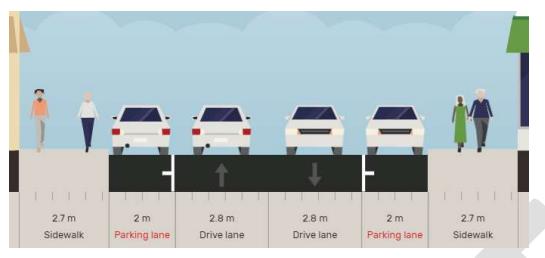
 4.2. Options considered and preferred option
1.Tinakori Road (Bowen Street to Hill Street)
Nature of the road
Shortlist
Preferred Option
Reasons
4.2. Options considered and preferred option
1.Tinakori Road (Bowen Street to Hill Street)
Nature of the road
Shortlist
Preferred Option
Reasons
1. Uni-directional protected cycle lane
Town Centre
on each side (All parks removed)
Minor Safety improvements only, with
Uni-directional protected cycle lanes which ranked highest
transformation team looking to make more
will provide a better outcome for people on bikes, however
ADT: 12,841 vehicles
2. Uphill protected cycleway (50% parks
significant changes in the future. Reducing
it will have a significant impact on local businesses in an
removed)
Narrow corridor, 9.4m
vehicle speeds through traffic calming
area which has a high place function and an existing speed
3. Minor Safety improvements
measures such as kerb build outs and
limit of 30kph. The proposed treatment for other transitional
only, including parklets, kerb
extending 30km/hr limit. Pedestrian
cycleway projects with a similar village / town-centre section
build outs, raised pedestrian
improvements with raised pedestrian
such as Aro Valley is to retain the parking and reduce
crossing and extending the
crossing. Parklets opportunities to increase
speeds (current average operating speed ~30km/h) as
30km/hr speed limit.
bike parking and amenities.
much as possible. This section of the proposed network is
also identified as a secondary route with the primary route
running down Bowen Street. For the reasons set out above,
the preferred option is 3 (minor safety improvements)
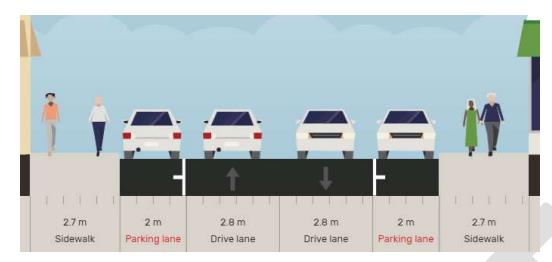
 2. Hill Street
Nature of the road
Considered/shortlisted
Preferred Option
Reasons
2. Hill Street
Nature of the road
Considered/shortlisted
Preferred Option
Reasons
1. Uphill protected cycleway (50%
Mostly residential use
Minor Safety improvements only, with
Due to the lower traffic volumes using this section and the
parks removed)
and school
transformation team looking to make more
opportunity to leverage off existing traffic calming measures
2. Minor safety improvements
significant changes in the future. Reducing
the preferred option is 2 (minor safety improvements).
ADT: 2,677 Vehicles
only including parklets, kerb
vehicle speeds through traffic calming
Minor safety improvements for Hill St also aligns with the
Narrow corridor, 9.7m
build outs, raised pedestrian
measures such as kerb build outs and
preferred option for Tinakori Road with both Hill St and
wide road.
crossing and extending the
extending 30km/hr limit. Pedestrian
Tinakori Road being secondary cycling routes and reflects
30km/hr speed limit.
improvements with raised pedestrian
the narrower corridor width being well placed for a traffic
crossing. Parklets opportunities to increase
calming approach.
bike parking and amenities
WCC Project Business Case MODERATE template.docx (Moderate) Thorndon Connections Transitional Project
Page 19 of 40
 3. Aitken Street
Nature of the road
Considered/shortlisted
Preferred Option
Reasons
1. Buffered cycle lane outside
3. Aitken Street
Nature of the road
Considered/shortlisted
Preferred Option
Reasons
1. Buffered cycle lane outside
Angle parked cars, low
Buffered cycleway outside parking.
Due to the lower traffic volumes and speeds (~25km/h
parking
volume commercial
Relocating the angled parking to parallel
average operating speed) on this section of the route and
zone.
2. Protected cycle lane both sides
parking removing some parking spaces.
the need to accommodate bus layover spaces, Option 1
Ensuring design is consistent and doesn’t
(buffered cycle lane outside parking) is proposed to be
ADT: 2,585 Vehicles
3. Minor safety improvements only
impend on the temporary bus layover
taken forward to concept design. This street was not
12m wide road.
spaces.
originally identified as part of the Wellington Bike Network
but through more detailed network planning analysis has
shown to be an important connector into the city.
WCC Project Business Case MODERATE template.docx (Moderate) Thorndon Connections Transitional Project
Page 20 of 40
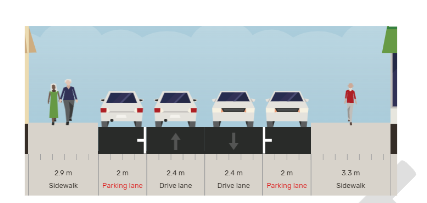
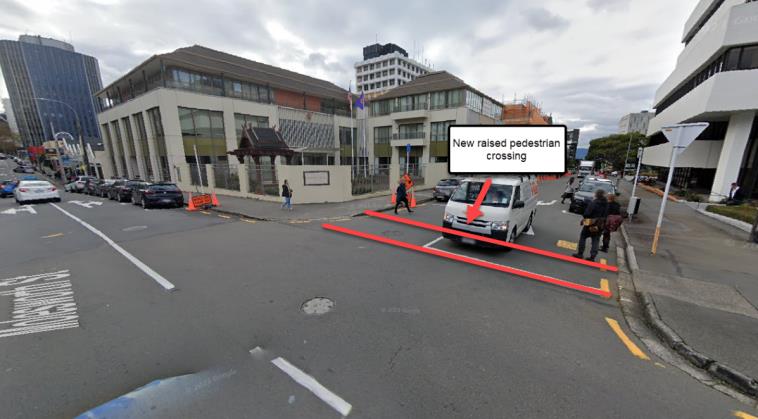 4. Pipitea Street
Nature of the road
Considered/shortlisted
Preferred Option
Reasons
4. Pipitea Street
Nature of the road
Considered/shortlisted
Preferred Option
Reasons
Minor Safety improvements only. Reducing
Commercial, parallel
1. Painted uni-directional cycle lanes
Due to the low traffic volumes and narrow cross-section
vehicle speeds through traffic calming
parks
on this section of the route, Option 3 (minor safety
2. Protected bi-directional bike lane +
measures. Pedestrian improvements with
improvements only) is proposed to be taken forward to
ADT: 2,891 Vehicles
convert to one-way road
new raised pedestrian crossing. Sharrows to
highlight cyclists to drivers.
concept design. This will ensure better connectivity and is
9.43 metres wide
3
.Minor Safety improvements only
inline with the approach to similar streets eg Hill Street.
This street was not originally identified as part of the
Wellington Bike Network but through more detailed
network planning analysis has shown to be an important
connector into the city
WCC Project Business Case MODERATE template.docx (Moderate) Thorndon Connections Transitional Project
Page 21 of 40

 5.Molesworth, Mulgrave, and Murphy Street
5.Molesworth, Mulgrave, and Murphy Street
Red indicating bi-directional facility and blue uni directional. Eyes indicate direction of street mixes perspective.
WCC Project Business Case MODERATE template.docx (Moderate) Thorndon Connections Transitional Project
Page 22 of 40

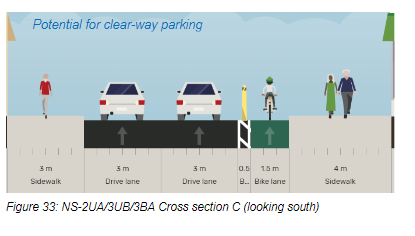
WCC Project Business Case MODERATE template.docx (Moderate) Thorndon Connections Transitional Project
Page 23 of 40
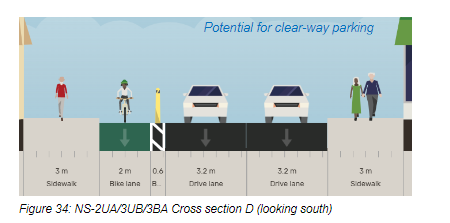
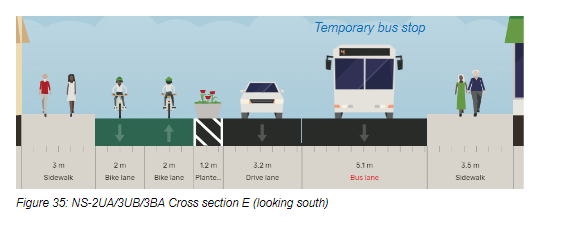
Note this section is now proposed to be reduced to one lane to allow loading zone at 61 Molesworth Street
WCC Project Business Case MODERATE template.docx (Moderate) Thorndon Connections Transitional Project
Page 24 of 40
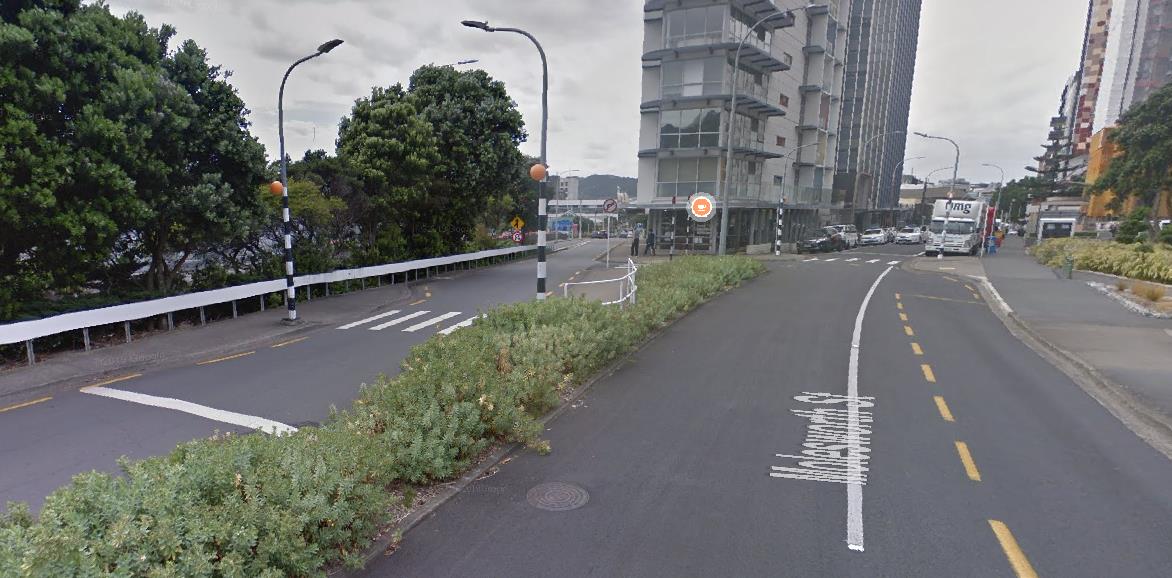
Proposed raised crossings
Nature of the road
Considered/shortlisted
Preferred Option
Reasons
4. Protected cycle lane in each direction (Molesworth
• Protected cycle lanes in both
High volume
The preferred option to be taken forward to concept
uphill and Mulgrave downhill)
directions on Molesworth and
connection to SH1
design is option 3 (Protected cycle lanes both
Murphy Street.
5. Bi-directional cycle facility on Molesworth Street
directions with bidirectional facility on part of
ADT:
full-length
• Raised pedestrian crossing at
Molesworth Street). Option 3 offers the following
9,079 Molesworth
the top of Murphy Street in
6. Protected cycle lanes both directions with
advantages over option 1 (Protected cycle lane in
order to slow vehicles where
each direction):
8,582 Murphy Street
bidirectional facilities on part of Molesworth Street
there is insufficient space for a
• Greater cycling network connectivity with the
9.5 meters wide
cycle facility.
•
bi-directional cycleway on lower Molesworth
Bi-directional cycle facility
on
Street allowing cyclists to take a shorter route
Molesworth Street between
to Lambton Quay and The Terrace
Lambton Quay and Aitken
Street
• Insufficient traffic lane width on upper Murphy
Street (3.8m) to provide a protected cycleway
section of bi-directional cycleway on
Molesworth St between Murphy St and May
was considered in order to provide a
connection to the Ministry of Health.
However, this sub-option was discounted due
WCC Project Business Case MODERATE template.docx (Moderate) Thorndon Connections Transitional Project
Page 25 of 40
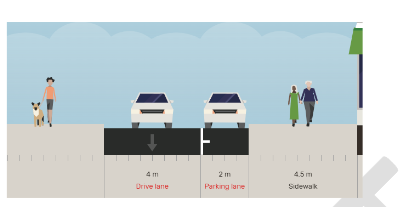
to the compromised legibility of changing
from uni-directional to bi-directional and back
to uni-directional.
6. Bunny Street West
Nature of the road
Considered/shortlisted
Preferred Option
Reasons
Shared space, low
1. Retain existing shared street
Retain existing shared street,
The preferred option for Bunny Street west is to retain
volume only access to
2. Shared lane westbound, narrow painted cycle lane improve shared space with
the existing shared street due to the low traffic volumes
5 Mobility parking
eastbound
roadway art
and speeds. Bunny Street west currently allows
spaces and Victoria
3. Shared lane westbound, protected cycle lane
cyclists to travel in the eastbound direction with
University Loading
eastbound.
Victoria University, buses and cyclists allowed to travel
zone
in the westbound direction. In discussions with Metlink
it was agreed that access for buses to Bunny Street in
ADT: 479 vehicles
the westbound direction needed to be retained to allow
Narrow road: 6.4m
buses to reposition via Bunny Street west. Potential
wide
improvements to the existing layout to be investigated
include road art and relocating the bus layout space.
WCC Project Business Case MODERATE template.docx (Moderate) Thorndon Connections Transitional Project
Page 26 of 40
 7. Lambton Quay (Whitmore Street to Bunny Street)
Nature of the road
Considered/shortlisted
Preferred Option
Reasons
7. Lambton Quay (Whitmore Street to Bunny Street)
Nature of the road
Considered/shortlisted
Preferred Option
Reasons
Limited parking, school 1. Protected cycle lane northbound, shared lane
Bi-directional cycle facility east
Option 2 is the preferred option because it seamlessly
bus stops
southbound
side connecting with the Golden
ties into the proposed bi-directional cycling facility on
2. Bi- directional cycle facility east side
Mile facility.
Lambton Quay south of Whitmore St. This is because
ADT: 8,761 vehicles
3. Bi-directional cycle facility west side
it is logical for cyclists to be able to continue along
Wide road: 23.4m
Lambton Quay on a continuous bi-directional cycleway
rather than needing to change facility types at
Whitmore St. In discussions with the Golden Mile
project team, it was confirmed that construction of
Thorndon Transitional Cycleways programme
implementation dates could be aligned with the Golden
Mile avoiding the need for an interim layout.
WCC Project Business Case MODERATE template.docx (Moderate) Thorndon Connections Transitional Project
Page 27 of 40
5. Procurement Approach
5.1. What is our procurement approach?
Implementation will be approved by the Senior Responsible Owner with final design signoff from the asset
owner.
All procurement on the programme is coordinated by WCC’s Commercial Partnerships team. Four main
services that we have procured/are procuring:
• Design Services,
• Road Safety- and Accessibility- auditing Services,
• Engagement Services, and
• Construction Contractor Services.
Design
The Transitional Programme is using WCC’s Master Services contract for design services with two design
consortia which has been setup to deliver design to the LGWM and the Transitional Programme. The benefit
is that these consortia work in the same geographical areas. The consortium working on this project is the
Future Group consortium including WSP and Stantec.
Road Safety and Accessibility Auditing services
We have procured ViaStrada appointed through a closed RFQ with a focus on smaller providers with
experience in the urban multi-modal realm.
Engagement services
The transitional programme is currently running a competitive tender to procure these services with the
support of the Commercial Partnerships team.
Construction services
The Transport and Place Planning Delivery team will implement, and project manage the construction of the
proposed transitional cycleways. The team is establishing a panel of suitably skilled and qualified providers
who have the range of skills that will be required. WCC has a strong broader outcomes agenda that will look
to specifically target this work using local suppliers within the Greater Wellington Region.
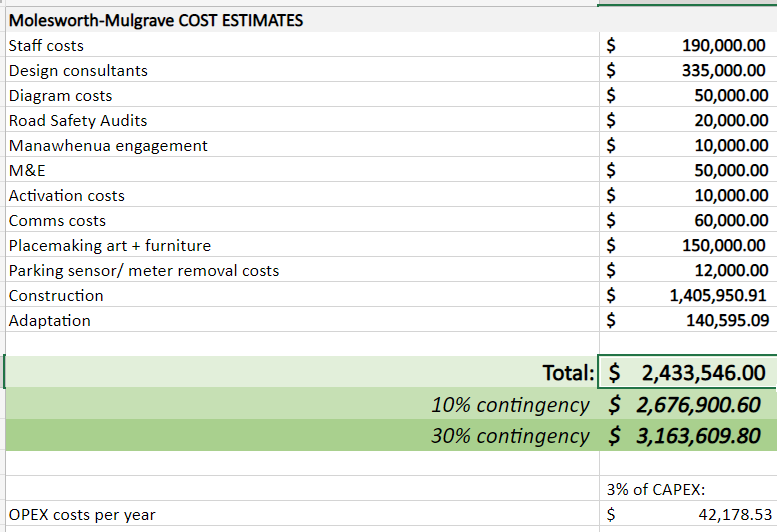 6. Funding Approach
6.1. Funding Arrangement
6. Funding Approach
6.1. Funding Arrangement
Funding for the transitional cycleways has been approved as part of the Bike Network plan.
Estimated costs based on concept designs are $2,676,900 - $3,163,609 based on a 30% contingency as
outlined below to allow for risk and uncertainty at this stage of design. Link in Appendix 10.
6.2. Operational/Post Project Funding
Post project funding arrangements include 3-4% of the project construction budget to allow for
maintenance of the proposed cycleways.
Projected
Financial year
costs
22/23
23/24
24/25
25/26
26/27
Total
Capital expenditure
$2,000,000
$1,163,609
$3,163,609
Operating
$42,178 -
$42,178 -
$42,178 -
$126,534 - $168,714
expenditure
$56,238
$56,238
$56,238
Total expenditure
$2,000,000
$1,163,609
$42,178 -
$42,178 -
$42,178 -
$3,290,143 - $3,332,323
$56,238
$56,238
$56,238
WCC Project Business Case MODERATE template.docx (Moderate) Thorndon Connections Transitional Project
Page 29 of 40
6.3. BCR
We have done a BCR calculation which returned a BCR of 1.08 over the first five years based on the
estimated cost with 20% contingency. A 20% contingency was used for the calculation as this is what is
recommended in Waka Kotahi guidance however, we are requesting funding up to 30% contingency due to
the transitional nature of these projects which increases uncertainty
Sensitivity analysis has been done below on what adding a 10% and 20% increase on top of this would do to
the BCR. The duration of benefits that will be accrued from this project will depend on the outcome of the
Transformational team business case.
Total over project life (all
Project
numbers discounted)
Cycle facility benefits
$203,945
Cycle health benefits
$337,842
Increased cycle safety
$54,554
Increased pedestrian safety
$7,268
Increased car safety
$219,198
Total benefits
$3,249,244
Total costs (@20%
contingency)
$3,015,180
Net benefit
$234,064
BCR
1.08

Sensitivity Analysis on this BCR is as follows:

Sensitivity
BCR
Increased Cost by 10%
1.04
Increased cost by 20%
1.00
Decreased Cost by 10%
1.12
Decreased Discount to 3%
1.10
Increased Discount to 6%
1.03
The rise in cycling numbers is decreased to 4 %
1.01
The rise in cycling numbers is increased to 10 %
1.14
Project lasts 10 years (Transformation programme does not go
ahead)
2.37
The BCR calculation can be found at Appendix 4.
7. Project Management Approach
7.1. Project Approach
The transitional street changes are intended to be an interim solution before permanent upgrades seeking
the same objectives are delivered. The project will adapt based on public consultation and findings where
necessary, there may be unforeseeable circumstances that lead to removal of the transitional cycleway, but
these will be managed at the time, in consultation with stakeholders. The project is being delivered using
temporary and quick install materials so any changes made are low cost and can be arranged relatively
quickly. The data and other evidence gathered will also help with the adaptation of the bus and bike
improvements.
Specific councillor support for the Thorndon Connections Transitional Cycleway will be confirmed again
during the Traffic Resolution process.
WCC Project Business Case MODERATE template.docx (Moderate) Thorndon Connections Transitional Project
Page 30 of 40
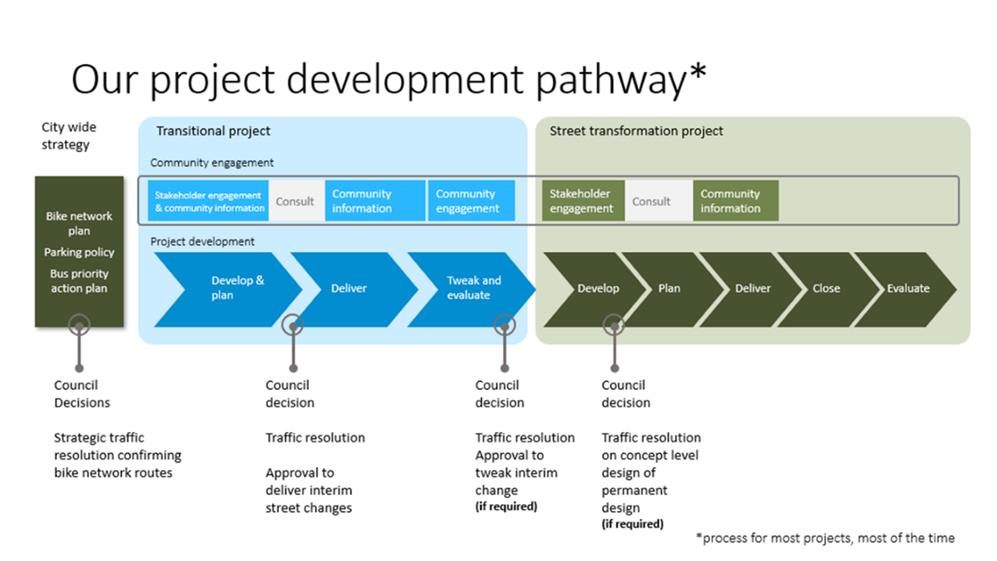
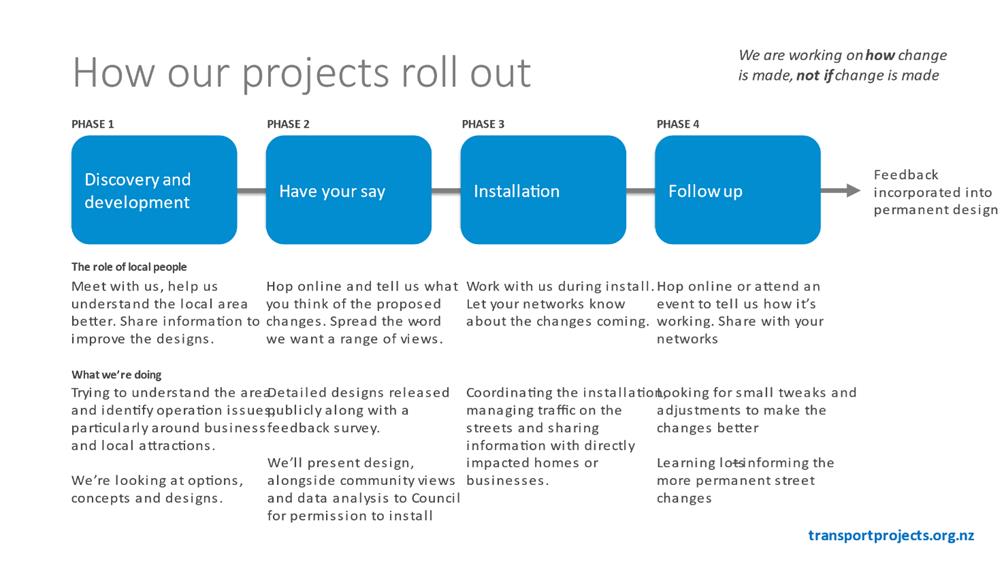
The adaptive approach of the project is explained in the diagram below.
7.2. Implementation Plan
Following the WCC Investment Delivery Framework process, upon approval of business case, the project
manager will be accountable for planning, coordinating and overseeing the project implementation as well as
coordinating and overseeing all pre-implementation activities.
Pre-implementation activities include ensuring the completion of the detailed design package, stakeholder
management and engagement including the traffic resolution process, risk management and procurement of
construction services.
The engineer contract will follow standard 3910 construction contract administration protocols including, but
not limited to, issuing and responding to notices to/from contractor, responding to requests for information
and conducting field inspection for quality control and to ensure conformance with design drawings and
relevant standards.
WCC Project Business Case MODERATE template.docx (Moderate) Thorndon Connections Transitional Project
Page 31 of 40
There will be monthly reporting to the SRO.
Implementation will be approved by the SRO with final design signoff from the asset owner.
The programme squad (internal stakeholders who have a role in reviewing and making recommendations)
and working group are kept up to date with project progress fortnightly. They are project advisors who
provide formal feedback into each of the design stages.
The project falls under the wider Bike Network programme which is managed by Hazel Durkin, Bike Network
programme manager.
WCC Project Business Case MODERATE template.docx (Moderate) Thorndon Connections Transitional Project
Page 32 of 40
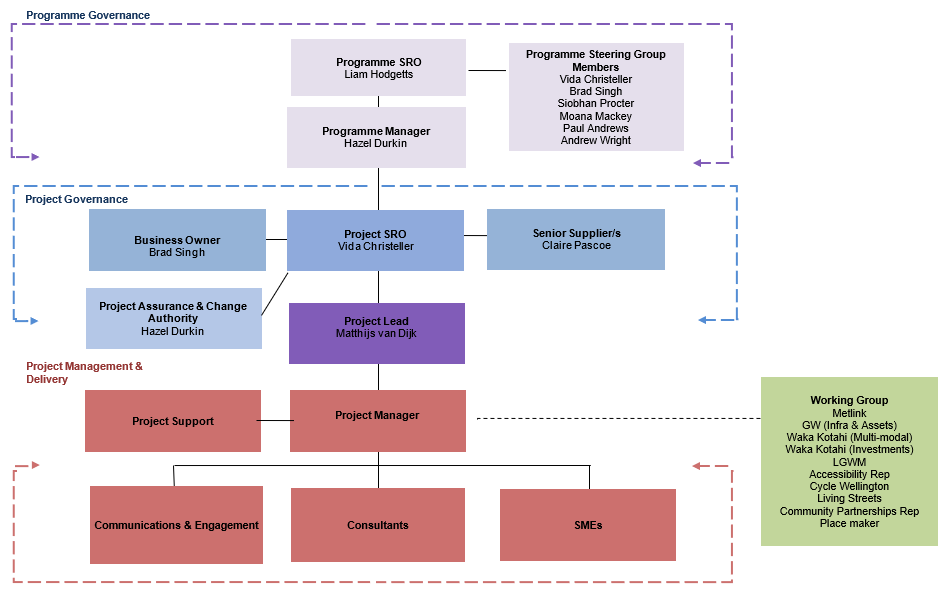 7.3. Transitional projects governance structure
7.3. Transitional projects governance structure
The following internal programme squad are consulted at each step of the design process and provide
review input:
• Traffic Engineer - Dennis Davis
• Signals Engineer – Haydn Wardley
• Principal Transport Engineer – Daniel Cairncross
• Delivery specialist – Stephen Harte and Dale Bowman
• Urban Designer – Paige Boyd
• Traffic Signals Specialist – Tim Kirby
• Behaviour Change Specialist – Georgia Halley
• Network Manager – Denise Beazley
• Evandro Scherer, Peter Hamilton and Kylie Hook
• Parking Services Specialist – Renee Reedy and Karan Parkinson
7.4. Risk and Assurance Planning
Risk information
Describe the risk
Risk rating
Risk treatment/ mitigation
(including cause and impact)
If we do not coordinate projects and
Early communication with other projects
communications with the other WCC and wider
including the bus interchange, reworking
transport projects including LGWM and
designs to ensure limited rework of
construction sites in this area we could create
High
intersection. Early communications with
disconnected network and upset residents and
61 Molesworth Street to determine if
businesses and lose the goodwill of the
TMP can incorporate cycleway.
community.
Business readiness engagement can
encompass the wider picture. Ongoing
communication between projects and
alignment of timelines to minimise
disruption for residents and businesses.
The visibility of the project to embassy
High
Brief local MP and connect with
parliament staff might mean the project's profile
parliamentary services to ensure early
is easily elevated to national levels (both +ve
engagement and to promote awareness
and -ve) meaning increased scrutiny and time to
of project. Understand any concerns that
manage that.
arise early to provide response and
communicate clear story with key
messages.
If the scope of work desired is too great for
High
Undertake Road Safety Audits at 30%
interim solutions, we will need to compromise
and 90% designs to identify safety
design which could lead to safety issues and
issues. Focus on the Moderate and
cycle uptake.
Severe risks and look at options to
alleviate through design. Work closely
with Transformation team for next step
improvements
If the loss of parking leads to more push back
Medium
Balancing this in decision making
by businesses, residents, and other
informed by comprehensive on and
stakeholders this could lead to compromised
offstreet parking assessments at the
cycleway infrastructure.
MCA stage and seeking alternative
solutions or phased approaches.
Production of a Parking Management
Plan in accordance with the Parking
Policy and specific engagement strategy
with Businesses, Residents Association,
Schools and Community groups.
If the Traffic resolution prior to install is not
Medium
Regular briefings and updates to
supported by elected members this will lead to
councillors, show how the community
redesign or halt to the project
has fed into the design process and how
it continues after the TR and install. Be
clear what has been considered and
what hasn't and why. Be clear about
what we will monitor
If unable to implement protected cycleways and
Medium
Communication plan with the public to
public expectations too high, it could result in
provide context of transitional cycleways
lower uptake and reputational impact
to manage expectations.
If there isn't enough behavioural 'how-to' work to
Medium
Ensure communication is clear and
complement delivery, the cycleway on the right
activations raise awareness of new road
hand side may confuse people and be opposed
layouts.
If contractor resources are constrained, then it
Medium
Early contractor procurement to commit
leads to delay in implementation and
resources.
reputational damage
If material availability is delayed, then it will
Medium
Early procurement of materials that
delay the delivery timelines leading to
require freighting or manufacturing i.e.
reputational damage
hit posts
If costs of the project are perceived as high
Medium
Communication and engagement
given permanent planned works, then the
through our comms channels
project can lose public support / reputational
damage.
If the shortage of parking enforcement staff
Medium
Provide clear comms through our usual
leads to insufficient enforcement, some of the
channels, consider visual signs (VMS) at
cycleways/lanes will be used as parking leading
sections that have this risk
to safety & reputational issues
WCC Project Business Case MODERATE template.docx (Moderate) Thorndon Connections Transitional Project
Page 34 of 40
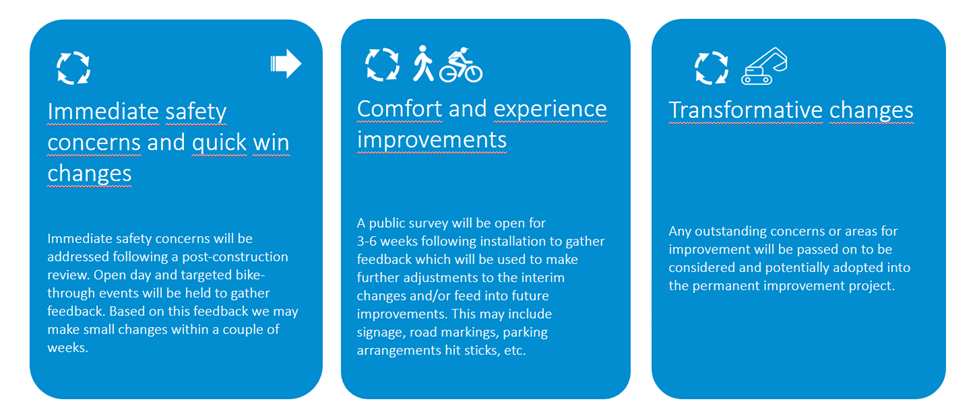 If the project team reaches capacity due to the
Medium
Comms and engagement planning.
number of projects happening concurrently. This
Identify when extra capacity is needed
could mean that there is an overwhelming
early, and bring in resource (from within
stakeholder or communication load that isn't
WCC or contactor) when required
effectively managed, creating reputational risks
If using in-lane bus stops, this could have
Low
Engagement with emergency
significant impact to emergency responders and
responders and key stakeholders to
network operations, the programme reputation
understand requirements and
will be damaged
incorporate into the design. Using
If the project team reaches capacity due to the
Medium
Comms and engagement planning.
number of projects happening concurrently. This
Identify when extra capacity is needed
could mean that there is an overwhelming
early, and bring in resource (from within
stakeholder or communication load that isn't
WCC or contactor) when required
effectively managed, creating reputational risks
If using in-lane bus stops, this could have
Low
Engagement with emergency
significant impact to emergency responders and
responders and key stakeholders to
network operations, the programme reputation
understand requirements and
will be damaged
incorporate into the design. Using
adaptable materials that can be
changed.
If the accessibility is compromised through
Low
Accessibility Audits at 30% and 90%
design, then sections of the community will be
designs to identify critical issues and
excluded through the new infrastructure
resolve through design.
Position responsible for any escalated risks Chief Planning Officer
Chief Infrastructure Officer
Project assurance processes in place
1. Risks are managed and monitored by the assigned project manager
in the Project Control book
8. The project’s weekly WIP meeting is a platform for the project team
to discuss/update/raise risks
9. Significant project risks (as earmarked by the project manager) are
included in the Project Control Book (Appendix 6)
10. All risks are assigned to an owner who is responsible for monitoring
specific risks
11. Significant project risks are raised during the monthly programme
board meeting
Risk allocation
All risks will be managed by Wellington City Council
The process and response hierarchy for post implementation changes
WCC Project Business Case MODERATE template.docx (Moderate) Thorndon Connections Transitional Project
Page 35 of 40
7.5. Change Management Approach
Once the business case is agreed any changes to project scope will be fully documented with reasoning in a
change register. If the project starts to deviate from approved project cost, time or scope we will use the
change request processes provided by the PMO and seek board approval.
7.6. Benefits Management Approach
The programme will have a 0.5 FTE dedicated to assisting the project managers with the monitoring and
evaluation on these projects.
The programme has a comprehensive monitoring and evaluation plan which starts by baselining before
implementation and ensuring ongoing measurement. We have a wider programme of work focussed on
rolling out more cycle counters on planned routes well ahead of implementation which will allow us to gather
good baseline data as well as show the impact of the transitional cycleways.
Our monitoring and evaluation of benefits has a close connection with communications and engagement.
We are using a baseline survey to help with engagement. Statistics from this survey help to inform our key
messages and communications during the project and after.
The monitoring and evaluation framework can be found at Appendix 5.
WCC Project Business Case MODERATE template.docx (Moderate) Thorndon Connections Transitional Project
Page 36 of 40
7.7. Project Management Planning
Please refer to Appendix 6 for the Project Control book.
Key Project Milestone
Description
Approximate
Date
Procurement
Procurement of professional services.
Completed
Project brief
Approval gained.
Completed
Discovery/Readiness engagement
Commence discussions with local businesses Completed
starts
and resident groups to understand their
needs and support levels
Concept design
Optioneering from shortlist to concept
– Completed
design of preferred option completed
Approval of Business Case by WCC
Seek approval to proceed with project
October 2022
30% Designs
Preferred option
October 2022
RSA on 30% Designs
Scheduled in
October 2022
90% Designs
Scheduled in
December 2022
RSA on 90% Designs
January 2022
Asset owner approval of 90%
Seeking approval for construction to
December 2022
Designs
commence.
Traffic Resolution consultation
Active business and community engagement April 2022
completed
Approval of Traffic Resolution by
May 2022
Planning & Environment Committee
100% designs signed off
May 2022
Pre-implementation commences
June 2022
Installation commences
Installation of the activity aim to commence
Q1 23/24
in 2023 and completed by 2024
Installation completed
Q4 23/24
Post implementation alterations and Adaptability to make tweaks based on
Ongoing as
tweaks
feedback post installation.
sections
completed July
2023 – June 2024
7.8. Next Steps
The team are working on a baseline survey for circulation on 31 October. The survey will ask questions
about how they currently experience the route and the suburb. A letter drop to the area will support this to
advise residents and businesses of the changes coming to the suburb and provide them with a link to the
survey. Analysis of survey feedback will feed into 90% designs in December.
Following the approval of the Business Case the project will proceed to 30% design on the preferred
concepts and we will seek further internal project team and external working group feedback as well as
safety and accessibility audits on the proposed designs. Once 30% designs are complete engagement will
focus on awareness in the area and further discussions with key groups.
WCC Project Business Case MODERATE template.docx (Moderate) Thorndon Connections Transitional Project
Page 37 of 40
The designs then proceed to 90% and preparation will begin for the traffic resolution
consultation.
Consultation on a traffic resolution for these sections is expected to take place in March 2023.
8. Recommendations
It is recommended that the SRO approves this Business Case and the recommended preferred option
presented above.
Approve:
Name
Title
Date
Note any comments made by the governance board, if any.
WCC Project Business Case MODERATE template.docx (Moderate) Thorndon Connections Transitional Project
Page 38 of 40
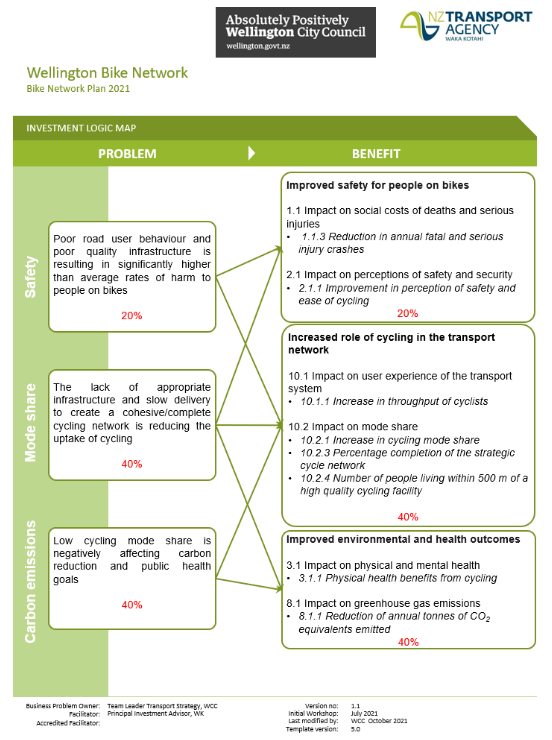 Appendix 1. Investment Logic Map
Appendix 1. Investment Logic Map
Taken from the Updated Bike Network Plan PBC:
WCC Project Business Case MODERATE template.docx (Moderate) Thorndon Connections Transitional Project
Page 39 of 40
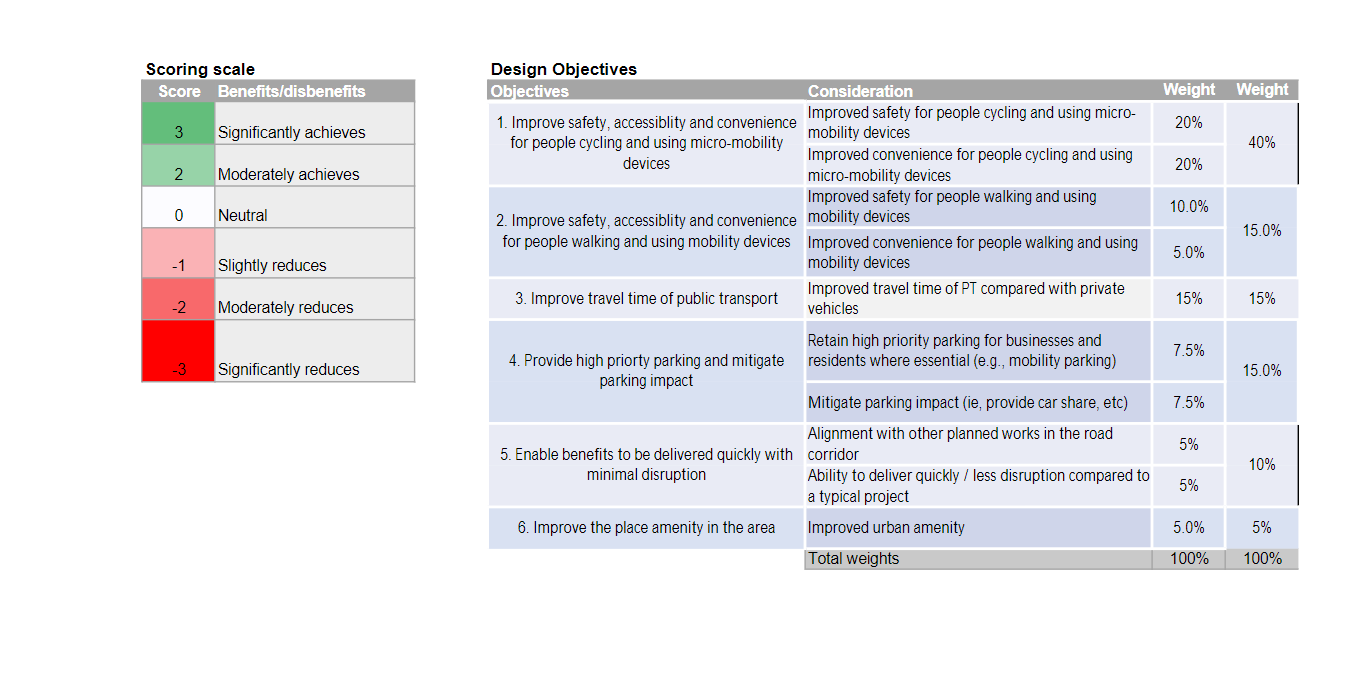
 Appendix 2. Multi Criteria Analysis Criteria and Scoring
Scale
2022-10-10_FINAL_Transitional Cycleways Multi Criteria Analysis - MM_with appendix.pdf
Appendix 2. Multi Criteria Analysis Criteria and Scoring
Scale
2022-10-10_FINAL_Transitional Cycleways Multi Criteria Analysis - MM_with appendix.pdf
Notes: Consideration should be given to fatal flaws, such as removing bus lanes, or causing significant
safety issues.
Appendix 3. 30% Concept Designs
5-C3880.32_C30-C40(A) (General Layout).pdf
5-C3880.32_C105-C106 (Molesworth St - Hill St - Aitken signals) C105-C106.pdf
Appendix 4. BCR calculation
Thorndon BCR calculations (003).xlsx
Appendix 5. Monitoring and Evaluation Plan
M&E for Thorndon Connections .xlsx
Appendix 6. Project Control Book
Thorndon Connections Project Control Book.xlsm
Appendix 7. Communication Plan
Thorndon Connections - Communication and Engagement Plan.docx
Appendix 8. Project Schedule
Thorndon Connections project schedule .mpp
Appendix 9. Cost breakdown
Thorndon Connections Cost Estimates.xlsx
WCC Project Business Case MODERATE template.docx (Moderate): Thorndon Connections Transitional Project
Page 40 of 40


























